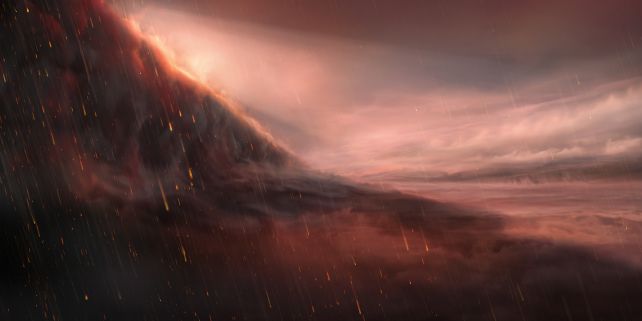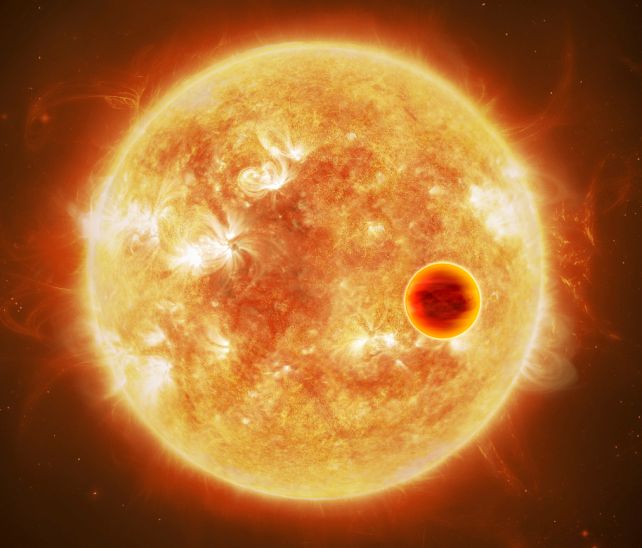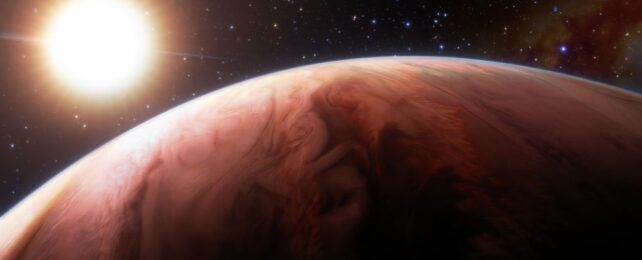A gas giant exoplanet 634 light-years away has a quirk in its atmosphere that suggests it may have swallowed a smaller world.
It's WASP-76b, and it's already famous for being one of the hottest exoplanets in the galaxy. Whipping around its host star once every 1.8 days, WASP-76b reaches temperatures above 2,000 degrees Celsius (3,632 Fahrenheit), and previous analyses of its atmosphere suggested that it rains liquid iron.
Now, led by astronomer Stefan Pelletier of the University of Montreal in Canada, an international team of astronomers has taken another look at this wild world. They've identified at least 11 separate elements in the gas giant's atmosphere – with some abundances that suggest planet-devouring tendencies.
"Truly rare are the times when an exoplanet hundreds of light years away can teach us something that would otherwise likely be impossible to know about our own Solar System," Pelletier says. "This is the case with this study."
WASP-76b is not the hottest known exoplanet in the galaxy, but it belongs to the category thereof. These worlds are known as hot Jupiters, gas giants within such close proximity to their stars that they reach mind-boggling temperatures. While hot Jupiters are often gas giants with similar masses to Jupiter, they have much much larger radii because the heat causes their atmospheres to expand.

This is the case for WASP-76b: It's about 90 percent of the mass of Jupiter, with a radius of about 185 percent that of Jupiter. And it orbits its star in such a way that it passes between us and it, meaning the starlight shines through the exoplanet's atmosphere during transits. Astronomers can analyze the light from the star to see how it changes during these times and dissect the spectrum to find out what elements are causing those changes.
Pelletier and his colleagues used an instrument called MAROON-X on the Gemini North telescope to obtain these s. They teased them apart to identify and quantify the elements swirling around in the scorching atmosphere of WASP-76b.
In addition to the iron already observed in the exoplanet's atmosphere, the team found sodium, calcium, chromium, lithium, hydrogen, vanadium, magnesium, nitrogen, manganese, potassium, and barium.
They also found vanadium oxide, which is particularly interesting: it's the first time this molecule has been detected unambiguously in an exoplanet.
"This molecule is of high interest to astronomers because it can have a great impact on the atmospheric structure of hot giant planets," Pelletier explains. "This molecule plays a similar role to ozone being extremely efficient at heating Earth's upper atmosphere."

Some elements seemed to be relatively absent. The team found no traces of metals like titanium and aluminum, which have high melting points compared to what was present in their observations. This, the team thinks, could mean that the upper atmospheres of hot Jupiters are very sensitive to temperature and may vary quite widely, even if their temperatures seem close.
Interestingly, the abundances of some of the elements they did find were very similar to those seen in WASP-76b's host star – and the Sun, too. But they're very different from the abundances seen in rocky worlds like Earth, Venus, Mars, and Mercury. This could be a clue about how gas giant planets form.
Rocky planets form gradually, from the bottom up, clumps of rock sticking together like a Katamari ball. Stars form from the top down, from a dense clump of material in a gas cloud that collapses under gravity and spools in gas to grow. The composition of WASP-76b could mean that gas giants, or some gas giants anyway, form similarly to stars.

But the elements that didn't quite match these abundances were also interesting, the researchers say. They suggest a case, at some point, of planet-on-planet crime.
"This is the first study to measure the abundances of chemical elements such as nickel, magnesium, and chromium at high precision in any giant planet," says astrophysicist Mohamad Ali-Dib of New York University Abu Dhabi in the United Arab Emirates.
"The deviations of their values from what is expected led us to postulate that WASP-76b might have swallowed another much smaller planet, one with the same chemical composition of Mercury."
The results suggest that we're just scratching the surface of what these strange, extreme worlds can tell us about the different ways planets can form and exist in our galaxy.
"Generations of researchers have used Jupiter, Saturn, Uranus, and Neptune's measured abundances for hydrogen and helium to benchmark formation theories of gaseous planets," Benneke says. "Likewise, the measurements of heavier elements such as calcium or magnesium on WASP-76 b will help further understanding the formation of gaseous planets."
The research has been published in Nature.
